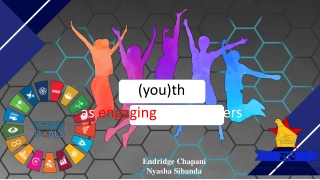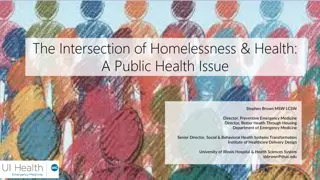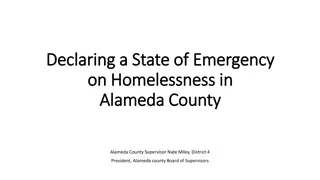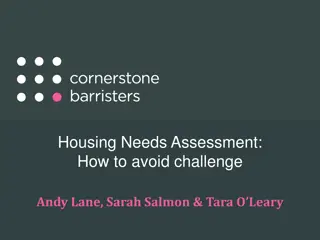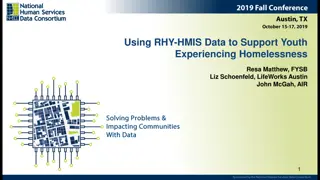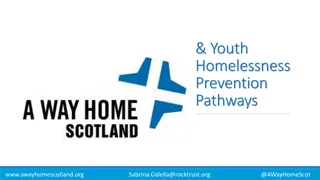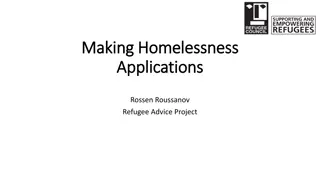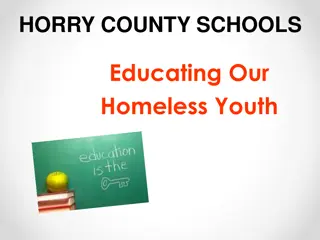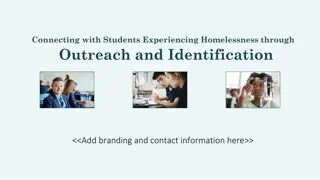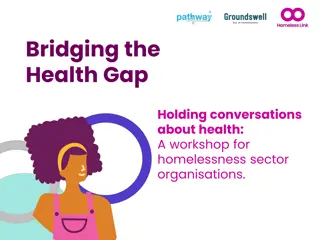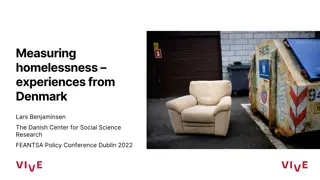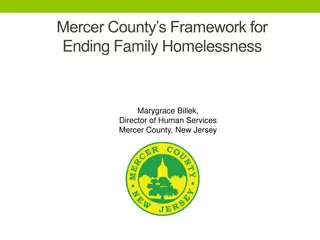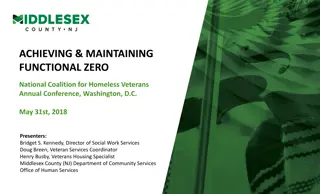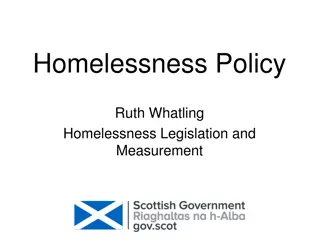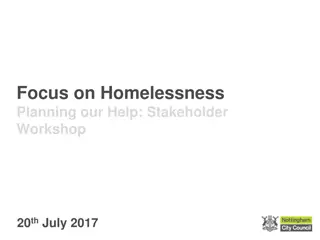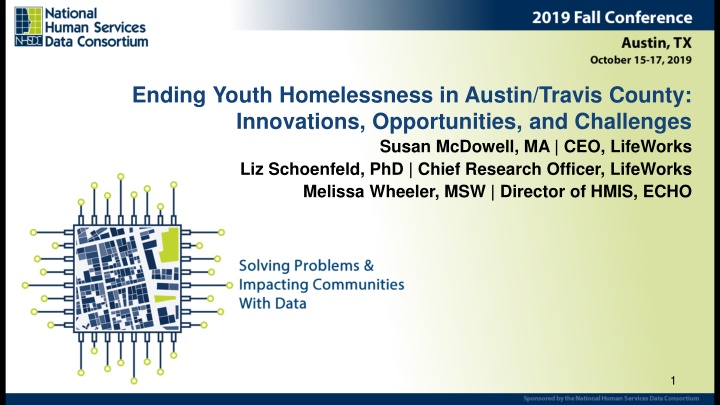
Innovative Strategies to End Youth Homelessness in Austin/Travis County
Discover the innovative approaches and challenges in the mission to end youth homelessness in Austin/Travis County. Learn about the Youth Homelessness Demonstration Program, wraparound support services, and effective YHDP programs like Diversion and Rapid Re-Housing. Follow the journey of Austin's community plan endorsed by HUD towards reducing youth homelessness and providing sustainable solutions.
Download Presentation

Please find below an Image/Link to download the presentation.
The content on the website is provided AS IS for your information and personal use only. It may not be sold, licensed, or shared on other websites without obtaining consent from the author. If you encounter any issues during the download, it is possible that the publisher has removed the file from their server.
You are allowed to download the files provided on this website for personal or commercial use, subject to the condition that they are used lawfully. All files are the property of their respective owners.
The content on the website is provided AS IS for your information and personal use only. It may not be sold, licensed, or shared on other websites without obtaining consent from the author.
E N D
Presentation Transcript
Ending Youth Homelessness in Austin/Travis County: Innovations, Opportunities, and Challenges Susan McDowell, MA | CEO, LifeWorks Liz Schoenfeld, PhD | Chief Research Officer, LifeWorks Melissa Wheeler, MSW | Director of HMIS, ECHO 1
Overview of the Youth Homelessness Demonstration Program (YHDP) The goal of the YHDP is to effectively prevent and end youth homelessness by 2020, meaning that youth homelessness is rare, brief, and non-recurring Part of Home, Together -- USICH s federal strategy to end homelessness more generally The first 10 communities were selected in January 2017, and 44 communities have been funded to date 2
Team & Timeline Austin is selected as one of 10 communities nationwide to serve as HUD s YHDP site ECHO awards 3 grants to LW to implement priority strategies. Austin participates in Chapin Hall s Voices of Youth Count Launch of PORT, Diversion and Rapid Re-Housing Austin reaches benchmarks for functional 0 July 2016 Nov. 2017 Apr. 2018 Feb. 2019 June 2016 Jan. 2017 Mar. 2018 Oct. 2018 December 2020 Participates in the A Way Home America 100 Day Challenge to house 53 young people Austin s coordinated community plan to end youth homelessness is approved by HUD. Austin City Council endorses plan as part of overall community plan to end homelessness. 25% reduction in youth homelessness; 56% reduction in unsheltered youth homelessness 3
The Importance of Wraparound Support The Strengths Model of Case Management Peer support Community-based mental health services (counseling & psychiatry) Evidence-based supported employment (Individual Placement & Support) 4
YHDP Programs Diversion: Assists youth at imminent risk of homelessness with financial support and wraparound services. Youth remain connected to support systems, stabilize, and maintain current housing or connect to safe and supported housing options. Permanency through Outreach and Rapid Transitions (PORT): Temporary housing for literally homeless youth (18-24). Youth may live in this dormitory-style, 15- bed shelter while they navigate into permanent rapid re-housing apartments. Rapid Re-Housing Plus : Time-limited financial assistance and targeted support services to connect youth experiencing homelessness to permanent housing; rental assistance available for up to 36 months and case management support available for up to 42 months. 5
YHDP Programs: Diversion 63 youth served to date Successes: Developing partnerships Ability to create what the system needs Challenges: Low enrollment Engagement & meaningful collaboration with partners 6
YHDP Programs: PORT 55 youth served to date Successes: Submitting amendment to add leasing budget line item Iterating program as needed Challenges: Low utilization Barriers to utilization 7
YHDP Programs: Rapid Rehousing Plus Total: 103 TAY enrolled, 87 TAY housed LifeWorks: 36 TAY enrolled, 27 TAY housed Caritas: 35 TAY enrolled, 29 TAY housed SAFE: 32 TAY enrolled, 31 TAY housed 8
YHDP Programs: Rapid Rehousing Plus Successes: Ramp-up in our community Cross-agency collaboration Keeping landlord outreach/housing navigation separate Challenges: Moves after initial move-in Progressive engagement Acuity of youth 9
Targeted Assertive Outreach An effort to determine the housing status of every youth currently in our local HMIS Intentionally reaching out to youth identified as experiencing homelessness to proactively provide services or inactivate the records of youth no longer in need of services We hope to divert youth from homelessness (or resolve their homelessness episode) before they are selected for a more intensive housing intervention Involves systematic outreach efforts to every youth, including those who are not yet selected to receive housing 10
Targeted Assertive Outreach Why? Need a clear number to inform broader community engagement efforts, to inform fundraising goals, and to better understand our progress toward the federal benchmarks Coordinated Assessment records remain open for the youth, unless someone informs ECHO that a youth is no longer in need of services (or until true outreach efforts begin when a youth is selected for housing) The number of youth who are in need of services is likely overinflated, based on the number enrolled in HMIS (some may have relocated, self-resolved, or entered an institutional setting) 11
Targeted Assertive Outreach Engaged in a six-week push to systematically reach out to every youth in HMIS Involved at least one email, 3 phone calls to every number provided (including back-up contacts), mailing a letter, reaching out to listed service providers, and physical outreach to youth s stated day locations (and mailing addresses) If unable to contact the youth after making these attempts (within 30 days), then the youth was be put on the BOLO list. After 30 days on BOLO, the record is inactivated. If the youth was contacted, then their housing status was assessed, and their record was either inactivated or they were referred to Diversion/Street Outreach. 12
Targeted Assertive Outreach Resulted in: 90 records being inactivated 143 BOLOs (6 youth were located) 99 referrals to diversion 13
Local Data Elements Conducting a comprehensive local evaluation Introduction of data elements to meaningfully assess progress toward USICH s four core outcomes (housing stability, permanent connections, employment/education, & well-being) Success is defined in relation to youth s self-defined goals 63.54% indicated they were interested in pursuing an education goal 46.60% indicated they were interested in pursuing an employment goal 27.84% indicated they were interested in pursuing a mental health goal 17.53% indicated they were interested in pursuing a substance use goal 14
Local Data Elements Operationalized constructs in a way that meaningfully links them to housing stability Also monitoring positive social connections, sense of safety, locus of control, self- esteem, hope, and resiliency Utilizing HMIS to track these data elements Partnered with vendor to implement the build-out Challenges: Burden for program staff Ongoing maintenance and support Other external requests for data 15
Monitoring Disparities 3.10%3.58% Black or African American Hispanic White 26.85% 40.45% Non-Hispanic White Other Missing/Refused/DK 26.01% 16
Monitoring Disparities: Ages 15-17 50.00% 42.31% 36.70% 36.10% 40.00% 30.77% 30.00% 16.76% 15.38% 20.00% 10.45% 7.69% 10.00% 0.00% Black or African American Hispanic White Non-Hispanic White Other Youth Exper. Homelessness in Austin/Travis County Austin/Travis County 17
Monitoring Disparities: Ages 18-19 50.00% 40.91% 39.30% 35.45% 40.00% 32.30% 30.00% 18.50% 20.00% 11.82% 9.80% 10.00% 3.64% 0.00% Black or African American Hispanic White Non-Hispanic White Other Youth Exper. Homelessness in Austin/Travis County Austin/Travis County 18
Monitoring Disparities: Ages 20-24 50.00% 41.60% 41.43% 40.00% 30.90% 28.86% 30.00% 23.86% 18.12% 20.00% 9.40% 10.00% 2.86% 0.00% Black or African American Hispanic White Non-Hispanic White Other Youth Exper. Homelessness in Austin/Travis County Austin/Travis County 19
Monitoring Disparities These discrepancies in TAY-SPDAT scores do not translate to amplified discrepancies in housing entries A higher proportion of Black/African American youth have successful housing exits relative to other races/ethnicities (87% v. 77% Hispanic v. 71% White) 20
Next Steps Ongoing systems work and partnership development Philanthropic push to meet the goal of ending youth homelessness by the end of 2020 Continued iteration of Diversion & the PORT Making the local data elements accessible and usable by direct service staff Sharing key learnings and recommendations 21

